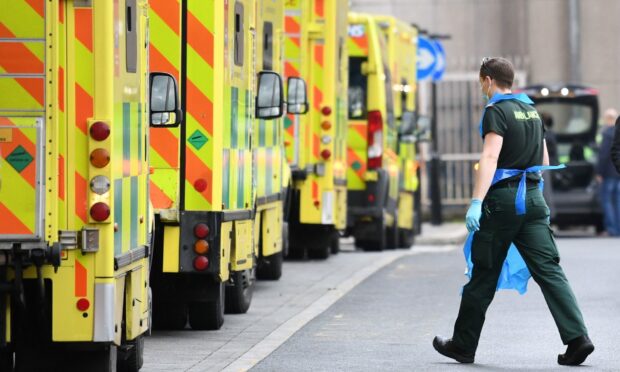The ambulance service is aiming to recruit hundreds more frontline staff as pressures caused by the pandemic continue to mount.
Plans are in place to recruit 356 front line paramedics, technicians and ambulance care assistants in the coming weeks.
This would bring the total of new recruits this year to just under 600 when combined with those that have been recruited over the last six months.
The push for new recruits comes as the NHS is struggling to cope with the impact of winter on its services.
In recent months, military teams have been called in to help multiple health boards across Scotland by driving ambulances and helping deliver vaccinations.
‘A real boost’
Pauline Howie, chief executive of the Scottish Ambulance Service, said there is little expectation that pressure on the ambulance service will decrease in the coming months, adding the recruitment of new staff would be a “real boost” to the efforts.
She said: “We know that this is one of the most significant periods of pressure on the NHS since its inception.
“All parts of the system are under pressure and it’s been tough out there for our staff and patients. Everyone is working so hard to help patients and our staff continue to do a fantastic job.
“We know that there will be little let up in those pressures over the next few months so we are accelerating our efforts to increase capacity and do everything we can to support staff. These new staff coming in will be a real boost.”
‘Staff continue to go above and beyond’
Ms Howie said that the recruitment of new staff would not only boost the capacity of the ambulance service, but would also pay tribute to those who who have worked in the NHS throughout the pandemic.
She said: “We continue to prioritise those patients who are most critically ill and staff continue to go above and beyond to save lives with survival figures for patients in our most acute response category at their highest ever level.
“It is a real testament to their ability to deliver despite the wider pressures upon the system. For those lower acuity patients who do have to wait longer for an ambulance, we are trying to get to you as quickly as we can and I’d once again thank you for your patience.”
The average 30-day survival rate patients within the NHS’ most seriously ill response category has risen to its highest level in recent months.
It rose steadily each month between January and May this year, peaking at around 50%.
Long wait times
Ambulance wait times have risen to an average of six hours this year, something First Minister Nicola Sturgeon described as “unacceptable”.
With fears that this will continue and worsen over the winter months, Ms Howie explained how the NHS is working to combat the waits.
She said: “We are taking a range of actions each and every day to reduce waits.
“We are working closely with NHS boards to address the hospital turnaround times to get our crews back on the road to help patients, we are boosting staffing numbers through accelerated recruitment, we are receiving great assistance from partners, using advanced paramedics, community first responders and other key staff to get to all categories of patients for example and our national command and control centre has been stood up to monitor waiting times and take immediate actions to identify and free up resources to attend patients waiting longer than we would like.”
‘Use 999 wisely’
To help support the ambulance service through the winter months, Ms Howie urged people to use it wisely.
She said: “As we move into the winter period, we would ask the public to continue to use 999 wisely.
If people have serious health concerns or symptoms, call 999. If your condition isn’t life-threatening, you should call NHS24 on 111.”
